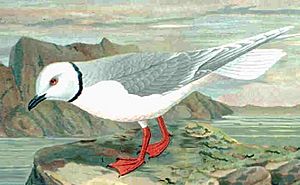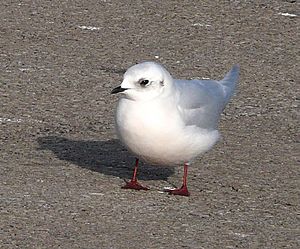Ross's gull facts for kids
Quick facts for kids Ross's gull |
|
|---|---|
 |
|
| Conservation status | |
| Scientific classification | |
| Genus: |
Rhodostethia
|
| Species: |
rosea
|
 |
|
| Synonyms | |
|
Hydrocoloeus roseus |
|
The Ross's gull (Rhodostethia rosea) is a small, special type of gull. It's the only bird in its group, called Rhodostethia. Some people think it should be moved to a different group that includes the little gull.
This bird is named after a British explorer, James Clark Ross. Its nesting areas were first found in 1905 by Sergei Aleksandrovich Buturlin. He discovered them near a village called Pokhodsk in northeastern Yakutia, a region in Siberia. The name Rhodostethia comes from old Greek words meaning 'rose' and 'breast'. The word rosea is Latin for 'rose-coloured'.
Contents
What Does a Ross's Gull Look Like?
This small bird looks a bit like the little gull, especially in its size and feathers. The Ross's gull is a little bigger and has longer, more pointed wings. It also has a tail shaped like a wedge. Its legs are red.
In summer, adult Ross's gulls are light grey on top and white underneath. Their chest has a pretty pink colour, and they have a neat black ring around their neck. In winter, the pink colour and neck ring fade away. A small dark mark appears behind their eye.
Young Ross's gulls look like winter adults. However, when they fly, you can see a dark "W" pattern on their wings. This is similar to young little gulls. It takes two years for young Ross's gulls to get their full adult feathers.
Here are some measurements for the Ross's gull:
- Length: About 29 to 31 centimetres (11.4 to 12.2 inches)
- Weight: About 140 to 250 grams (4.9 to 8.8 ounces)
- Wingspan: About 90 to 100 centimetres (35.4 to 39.4 inches)
Where Do Ross's Gulls Live?
Ross's gulls make their nests in the far northern Arctic regions. This includes northernmost North America and northeast Siberia.
When autumn comes, they only fly short distances south. Most of these birds spend winter in the northern parts of the Bering Sea and the Sea of Okhotsk. They stay near the edge of the pack ice. Some gulls travel to warmer places, like northwest Europe. For example, in February 2016, some were seen in Cornwall, England, and in Ireland. In North America, a Ross's gull was once seen as far south as the Salton Sea in California. However, seeing them that far south is very rare.
Their summer nesting areas are tundra lands. These areas have sedges, grass clumps, small willow bushes, lichens, and many small pools of water.
Ross's Gull Life and Habits
Ross's gulls build their nests in small groups, called colonies. They live on the tundras and in swampy areas near Arctic rivers. They often nest near other seabirds, like Arctic terns.
Reproduction
A female Ross's gull lays two or three eggs. The eggs are olive green with small reddish-brown spots. They build their nests on the ground, often on an island in a small lake. The nests are lined with seaweed, grass, or moss.
The parents take turns sitting on the eggs for about three weeks. This is called incubation. After the chicks hatch, they stay in the nest for another three weeks until they can fly. Not all young birds survive. Sometimes, predators or bad weather can harm them.
What Do They Eat?
Ross's gulls eat any small prey they can find. This includes small fish and crustaceans. In winter, they often look for food on muddy areas, much like a wader bird. During the time they are nesting, they mostly eat insects, such as beetles and flies.
See also
 In Spanish: Gaviota de Ross para niños
In Spanish: Gaviota de Ross para niños



